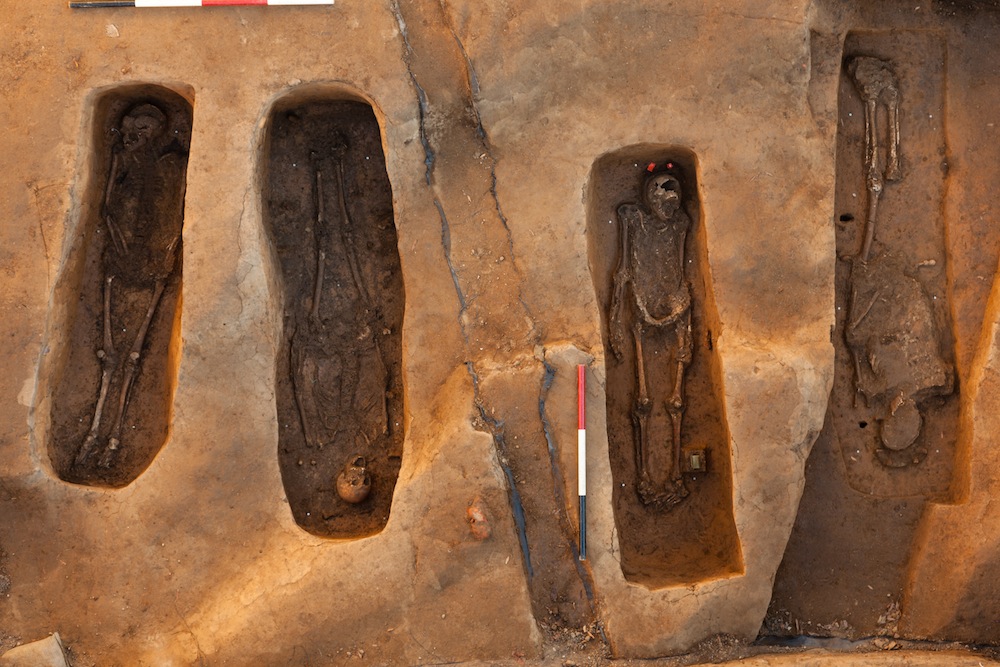
Editor's Note: This story was updated at 3 p.m. E.D.T. on July 24, 2018
Four lost leaders of the first permanent English settlement in the Americas have been identified, thanks to chemical analysis of their skeletons, as well as historical documents.
The settlement leaders were mostly high-status men who were buried at the 1608 Jamestown church in Virginia. And all played pivotal roles in the early colony.
"They're very much at the heart of the foundation of the America that we know today," said Douglas Owsley, a forensic anthropologist at the Smithsonian Institution in Washington, D.C., who helped identify the bodies. [See photos of the newly identified Jamestown settlers]
By analyzing the bones, researchers can get a snapshot of what it was like to live during the earliest days of America, Owsley said.
"It's a way of getting very detailed information you simply can't get from the history books," Owsley told Live Science.
First colonies
Sign up for the Live Science daily newsletter now
Get the world’s most fascinating discoveries delivered straight to your inbox.
Though the British had previously sent out settler ships (to the doomed colony of Roanoke), the British colonial adventure in America truly got started in Jamestown, Virginia.
English settlers disembarked from their ships in 1607 at an inland spot along the James River, marking a chunk of land as a prime location for a fortified settlement. Over the next few years, several boats would arrive, bearing hundreds of settlers to what would be called Jamestown.
But times were rough; during a six-month period in 1609 known as the "starving time," nearly 250 people died at Jamestown. At least some of the inhabitants resorted to cannibalism, according to a 2013 study by the same researchers.
Founding fathers
In 2013, Owsley and his colleagues first unearthed the bodies, near the historic Jamestown church where John Rolfe married Pocahontas. Two of the bodies were in fairly ornate, anthropomorphic coffins, though the bodies were poorly preserved.
To identify the men, the archaeologists combined genealogical and historical documents from both England and the colonies, along with artifacts and analyses of the chemicals in the skeletons. For instance, the elite often had higher levels of lead in their bones during this time, because they frequently used lead-containing pewter and lead-glazed ceramics for eating and drinking, Owsley said.
"These are high-status individuals, two of them particularly so," Owsley told Live Science.
One of the men was Ferdinando Weyman, who died in 1610 at around age 34. He was the uncle of Sir Thomas West, the governor of Virginia. Weyman was also related to another of the men identified, Captain William West. This man perished in 1610 after a fight with the Powhatan Indians. His body was identified thanks to a partly decayed, dirt-covered military sash that was found with the skeleton. The sash, still inside a block of dirt, was placed in a computed tomography (CT) scanner, which revealed a silk cloth decorated with silver fringe. [Photos: Time Capsule from 1795 Reveals Piece of American History]
Both West and Weyman were buried in human-shaped coffins with a distinctive pattern of nails. Weyman had higher lead levels in his bones than the other individuals, indicating his elite status.
Another of the newly identified men was Captain Gabriel Archer, who died during the starving time in 1609 at the age of 34. Captain Archer was buried with the leading staff, an arrow-tipped staff that he used, enabling the team to identify him. Archer was also buried with a small silver box, known as a reliquary, containing bone fragments and pieces of a lead container for holding holy water atop his coffin. The artifact suggests he may have secretly clung to his Catholic faith.
The last man of the group was Reverend Robert Hunt. Unlike the more affluent men, he was buried in a simple shroud, facing west, toward the congregation he headed. Hunt died in 1608 around the age of 39.
Lost to history
The research team may do further analysis to confirm the men's identities. The bodies were poorly preserved, but it may be possible to extract some usable DNA from the remains, Owsley said.
"Even as we speak, we're looking at genetic evidence to see if I can show the connection between Weyman, who would be the uncle of William West," Owsley said.
While the team would like to identify other individuals from historic Jamestown, that could prove difficult, as fewer traces remain of most of the settlers, the researchers said.
"If you're a woman in the 17th century, you live totally in the shadow of your husband," Owsley said. "Most people would come and go and die at Jamestown, and nobody would write a word about them."
Editor's note: This story was updated to note that Pocahantas married John Rolfe, not John Smith.
Follow Tia Ghose on Twitterand Google+. Follow Live Science @livescience, Facebook & Google+. Original article on Live Science.

Tia is the managing editor and was previously a senior writer for Live Science. Her work has appeared in Scientific American, Wired.com and other outlets. She holds a master's degree in bioengineering from the University of Washington, a graduate certificate in science writing from UC Santa Cruz and a bachelor's degree in mechanical engineering from the University of Texas at Austin. Tia was part of a team at the Milwaukee Journal Sentinel that published the Empty Cradles series on preterm births, which won multiple awards, including the 2012 Casey Medal for Meritorious Journalism.










